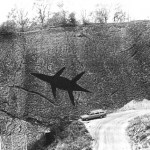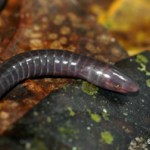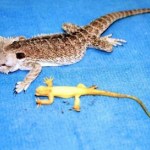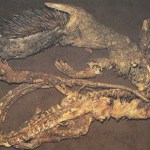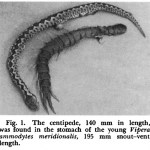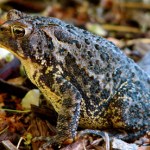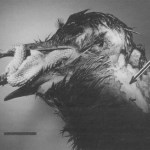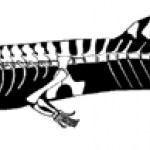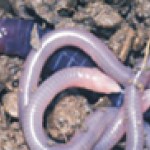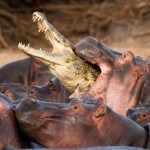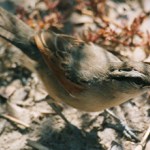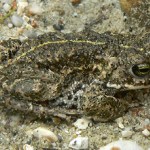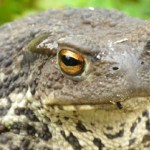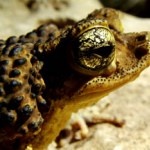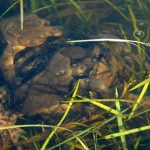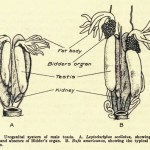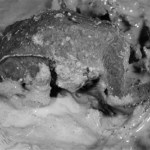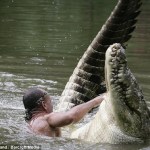herpetology
I have to admit that I don't find trace fossils - the vast majority of which are footprints - that interesting. But some trace fossils are very neat and provide excellent information on behaviour and lifestyle. Examples include pterosaur take-off traces, the trackway of the little theropod that does an abrupt about-turn and runs back the way it came, and the Myotragus tracks that show how individuals had to stagger and battle through wet sediment in order to escape alive.
Particularly fun are giant mystery traces: the ones made by large animals doing unusual things... yet what these large…
More thoughts on the ZSL meeting 'The Secret World of Naked Snakes', held on Monday 7th December. In the previous article I discussed Mark Wilkinson and David Gower's presentations [for relevance of pic used above, read on].
Alexander Kupfer was up next, and provided an excellent overview of reproductive diversity, viviparity and parental care in caecilians (his talk was titled 'Yummy mummy: skin feeding and caecilian reproductive biology') [images above, from Wilkinson et al. (2008), show mother Siphonops annulatus looking after, and feeding, babies]. Caecilians exhibit five different…
On Monday 7th December the Zoological Society of London (ZSL) hosted the one-off event 'The Secret World of Naked Snakes' (part of the ZSL's 'communicating science' series): a whole meeting devoted entirely to those bizarre, poorly known, limbless, worm-like amphibians, the caecilians. The meeting was attended by over 100 people, which really isn't bad going, especially when some of the organisers expressed fears that the event would only be attended by (to quote David Gower) "A handful of caecilian freaks".
Ken Livingstone [shown here] - former Mayor of London and well-known amphibian…
No time for anything substantive lately, though thoughts on the ZSL caecilian meeting coming up soon. Meanwhile, here's another short article in the 'over-enthusiastic swallowing' series: note that the articles aren't all about cases where animals choke to death. Some of them concern cases where the animals swallow insanely large objects, and still live to tell the tale. This time round, we look at the case of Mushu, a pet Central bearded dragon Pogona vitticeps, who was noted by her 7-year-old owner (Finley Collins) as having something unusual protruding from her vent.
Finley was (according…
In case it isn't obvious, I've decided to do a little series on 'over-eager swallowing'. And here's the latest instalment. Here's an unfortunate Perentie Varanus giganteus that died after trying to swallow a Short-beaked echidna Tachyglossus aculeatus...
The photo is from Kirschner et al. (1996), and the accompanying text is...
Auch freilebende Warane können sich einmal verschätzen. Dieser Riesenwaran wurde Opfer seiner Gier. Beim Versuch, einen Stacheligel zu fressen, fügte er sich tödliche Verletzungen zu.
... which basically says that the lizard was a victim of its own greed, and died…
Continuing with the theme of over-eager swallowing of large prey, I thought I'd share the following case, reported in the literature by Clark (1967). A Horned or Sand viper specimen belonging to the subspecies Vipera ammodytes meridionalis (sometimes called the Eastern sand viper) was caught on the Greek island of Euboia. It looked fat at the time of collecting, and died an hour later.
Dissection revealed what you see in the photo: this small snake had eaten, whole, a centipede 140 mm long. Wow, ambitious. While the possibility exists that handling and subsequent bagging somehow damaged the…
After a little delay, it's time to embark once more into the World of Toads!!! Having previously looked at toads in general, and at the toads of Europe, we here continue the series by looking at yet more familiar, northern toads: this time at those of North America.
As with some of the other 'northern' toads we've looked at (the Natterjack and the Green toad and its relatives), North America's many toad species have conventionally been subsumed into the anuran genus-that-ate-the-world, Bufo. However, genetic studies have shown that the North American toad clade that includes the Common…
Carnivorous animals often die from choking, and field biologists have done a good job of recording many such instances in the literature.
This image shows an unlucky young Roadrunner Geococcyx californicus found dead in Brisco County, Texas, in 1998. The bird had tried swallowing a Texas horned lizard Phrynosoma cornutum, and things clearly went horribly wrong. Other instances of this sort of thing are on record. Remind me to post the goanna vs echidna photo some time. The photo used here is from...
Holte, A. E. & Houck, M. A. 2000. Juvenile Greater roadrunner (Cuculidae) killed by…
Congrats yet again to Sterling Nesbitt and colleagues on the publication of another one of those insane Triassic hellasaurs, this time the surreal archosauriform* Vancleavea campi (Nesbitt et al. 2009) [adjacent life restoration by Sterling Nesbitt]. Vancleavea was named by Long & Murry (1995) and is well represented by various bits and pieces from the Upper Triassic of the southwestern USA (interestingly, it seems to have been around for a long time: like, 20 million years or so). Its affinities were initially unclear: all that was clear was that it was a weird, armoured diapsid reptile…
As a Tet Zoo regular you'll know and love the remarkable limbless amphibians known as caecilians.
In case you don't know, caecilians have sensory tentacles, sometimes have protrusible eyes, sometimes lack eyes entirely, often exhibit sophisticated parental care [maternal skin-feeding is going on in the middle image above], are incredibly long-bodied yet often lack tails, sometimes possess large, anatomically complex, eversible male sexual organs, and so on and so forth. Should you need to know more, please visit the links below. Due to their fossorial habits, a very confused taxonomic…
You've probably seen - presumably on TV - Nile crocs Crocodylus niloticus interacting with Common hippos Hippopotamus amphibius (if you've seen it in real life, lucky you). By and large the two seem to keep apart. Having said that, there are certainly photos of the two sharing the same sandbanks. And then there are those instances of hippos scaring crocs away from carcasses, the weird reports of hippos mouthing and chewing the backs and tails of resting crocodiles, and those cases where crocodiles have been seen to walk or run across hippos' backs.
What can certainly be said to be the most…
So, I recently returned from a brief sojourn in Libya. The trip was led by Richard Moody, best known for his work on Cretaceous sea turtles; I was also accompanied by palaeornithologist Gareth Dyke and by a group of people interested in the country's geology.
Libya - officially, the Great Socialist People's Libyan Arab Jamahiriya - is huge: it covers nearly 2 million square kilometres and is the fourth largest African county. However, 90% of the country is desert, and the population is only about 5.7 million (of which nearly 2 million live in Tripoli, the capital). It's a land of…
The Natterjack Epidalea calamita (introduced in the previous article) is a remarkable animal, well adapted for the dry, relatively saline environments it inhabits (there are places where Natterjacks inhabit saltmarshes, moors, and disused industrial areas). A proficient burrower, it starts digging a burrow with its forelimbs but does most of the work with its hindlimbs (hindlimb burrowing is typical for anurans, whereas forelimb burrowing is highly unusual). The burrows help the toads to gain access to moisture in dry habitats because they typically extend down to damp sediments; a…
If you've been following the toad series, you'll have read articles that introduce toads in general, discuss reproductive biology, and look at cranial anatomy. This can all be regarded as background introductory stuff. From hereon, we're mostly going to look at toad diversity in rough phylogenetic order: that is, starting at the base of the clade and working up to the 'top' of the tree [European common toad Bufo bufo shown here, from wikipedia. This individual has really weird nostrils].
Basal toads are all South American, and include the South American redbelly toads (Melanophryniscus) and…
Yes! MORE TOADS. You surely know what a toad's head looks like. But there's a lot about toad skulls that you almost certainly don't know, and the aim of this article is to review toad skull anatomy. This might seem like an arcane subject, but - as we'll see - the diversity of toad skulls is really quite remarkable and much of toad success can be put down to various of their cranial features (such as their parotoid glands and strong degree of cranial ossification)...
Whereas anurans typically have small teeth lining their upper jaws, toads are entirely toothless. However, tooth-like…
After a brief hiatus we return to the remarkable world of toads, and this time round we look at reproductive biology. As a western European person, the toad species I'm most familiar with (the Common toad Bufo bufo and Natterjack Epidalea calamita [see later articles for details on the name changes]) are seasonal breeders that turn up at ponds early on in the year [Common toad mating ball shown here, photo by Neil Phillips] and produce strings of hundreds or thousands of eggs (between 400 and 7500). There are other toad species that are even more fecund, with individuals of some species (…
One of the dirty little secrets of biology is that many groups of organisms have never been 'defined' in the phylogenetic sense: a group grows over time as people add new species to it, but they only do this because it 'feels' about right, not because there's any rigorous way of knowing whether those species really belong there or not. Many tetrapod groups - classic examples include Ranidae, Muscicapidae, Colubridae and Scincidae - lack characters that might allow their monophyly to be demonstrated, and modern studies show that various of their constituent members aren't more closely related…
I forget how it started now, but lately I've been very, very interested in toads (yes, toads), so much so that I've felt compelled to write about them. The problem is that toads - properly called bufonids - are not a small group. On the contrary, this is a huge clade, distributed worldwide and containing about 540 species in about 38 genera (as of October 2009). So, there are a lot of species to write about, and covering all or most of them is quite the challenge. But it's the sort of challenge I like...
As is so often the case with amphibian and reptile groups, accessible literature that…
What's going on in these pictures?
You might already know. If you do, feel free to spread the news.
On to our second day of talks (read part I first): things kicked off with Mike A. Taylor and Angela Milner's talk on the history and collections of Street. Pinpointing the locations of original quarries is always difficult as exact records are often not kept, and of course the areas once used for quarrying change function and appearance over time. One interesting point is that the concept of 'Street' as a locality should perhaps be interpreted as broadly as possible, given that certain other, nearby Somerset sources might sometimes have provided specimens too [adjacent photo by Mo Hassan of…
